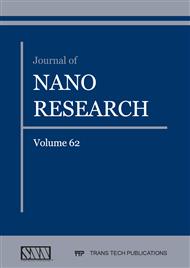[1]
M. Diaz, L. Wang, D. Li, X. Zhao, B. Conrad, A. Soeriyadi, A. Gerger, A. Lochtefeld, C. Ebert, R. Opila, I. Perez-Wurfl, A. Bernett, Tandem GaAsP/SiGe on Si solar cells, Sol. Energy Mater. Sol. Cells, 143 (2015) 113-119.
DOI: 10.1016/j.solmat.2015.06.033
Google Scholar
[2]
T. Takamoto, E. Ikeda, H. Kurita, Over 30% efficient InGaP/GaAs tandem solar cells, Appl. Phys. Lett. 70 (1997) 381-383.
DOI: 10.1063/1.118419
Google Scholar
[3]
T. Sato and M. Imai, Effects of nitrogen on GaAsP light-emitting diodes, J. Appl. Phys. 91 (2002) 6266-6272.
DOI: 10.1063/1.1469664
Google Scholar
[4]
F. Agahi, A. Baliga, K. M. Lau, N. G. Anderson, Tensile-strained barrier GaAsP/GaAs single quantum-well lasers, Appl. Phys. Lett. 68 (1996) 3778-3780.
DOI: 10.1063/1.116614
Google Scholar
[5]
T. D. Brown and G. S. May, Hybrid neural network modeling of anion exchange at the interfaces of mixed anion III-V heterostructures grown by molecular beam epitaxy, IEEE Trans. Semiconductor Manufacturing, 18 (2005) 614-621.
DOI: 10.1109/tsm.2005.858506
Google Scholar
[6]
A. V. Boitsov, N. A. Bert, Yu. G. Musikhin, V. V. Chaldyshev, M. A. Yagovkina, V. V. Preobrazhenskii, M. A. Putyato, B. R. Semyagin, Effect of isovalent doping with phosphorus on the cluster formation in gallium arsenide grown by molecular-beam epitaxy at a relatively low temperature, Semiconductors, 40 (2006) 758-762.
DOI: 10.1134/s1063782606070025
Google Scholar
[7]
R. F. Scholz and U. Gosele, Phosphorus and antimony in GaAs as tracers for self-diffusion on the arsenic sublattice, J.Appl.Phys. 87 (2000) 704-710.
DOI: 10.1063/1.371929
Google Scholar
[8]
T. Soga, J. Inoue, T. Jimbo, M. Umeno, OBSERVATION OF LATTICE-RELAXATION AT THE GAASP/GAAS INTERFACE BEYOND THE CRITICAL THICKNESS BY TRANSMISSION ELECTRON-MICROSCOPY, J. Appl. Phys. 75 (1994) 4510-4514.
DOI: 10.1063/1.355942
Google Scholar
[9]
X. Liu, A. Prasad, J. Nishio, E. R. Weber, Z. Liliental-Weber, W. Walukiewicz, NATIVE POINT-DEFECTS IN LOW-TEMPERATURE-GROWN GAAS, Appl. Phys. Lett. 67 (1995) 279-281.
DOI: 10.1063/1.114782
Google Scholar
[10]
E.R. Weber, H. Ennen, U. Kaufmann, J. Windscheif, J.Schneider, T. Wosinski, IDENTIFICATION OF ASGA ANTISITES IN PLASTICALLY DEFORMED GAAS, J. Appl. Phys. 53 (1982) 6140-6143.
DOI: 10.1063/1.331577
Google Scholar
[11]
M. Losurdo, P. Capezzuto, G. Bruno, A. S. Brown, T. Brown, G. May, Fundamental reactions controlling anion exchange during mixed anion heterojunction formation: Chemistry of As-for-Sb and Sb-for-As exchange reactions, J. Appl. Phys. 100 (2006) 013531.
DOI: 10.1063/1.2216049
Google Scholar
[12]
J.C. Bean, L.C. Feldman, A.T. Fiory, S. Nakahara, I.K. Robinson, GEXSI1-X/SI STRAINED- LAYER SUPERLATTICE GROWN BY MOLECULAR-BEAM EPITAXY, J. Vac. Sci. Technol. A, 2 (1984) 436-440.
DOI: 10.1116/1.572361
Google Scholar
[13]
D. Shindo, Y. Ikematsh, S. H. Lim, I. Yonenaga, Digital electron microscopy on advanced materials, Materials Characterization, 44 (2000) 375-384.
DOI: 10.1016/s1044-5803(00)00073-5
Google Scholar
[14]
A. Vila, A. Cornet, J. R. Morante, P. Ruterana, R. Bonnet, Structure of 60 degrees dislocations at the GaAs/Si interface, J. Appl. Phys. 79 (1996) 676-681.
DOI: 10.1063/1.360812
Google Scholar
[15]
Y. Q. Wang, Z. L. Wang, T. Brown, A. Brown, G. May, Configurations of misfit dislocations at interfaces of lattice-matched Ga0.5In0.5P/GaAs heterostructures, Appl. Phys. Lett. 77 (2000) 223-225.
DOI: 10.1063/1.126931
Google Scholar
[16]
B. C. DE Cooman and C.B. Carter, THE FORMATION OF FAULTED DIPOLES IN PLASTICALLY DEFORMED GAAS, Phys. Status Solidi A, 112 (1989) 41-54.
DOI: 10.1002/pssa.2211120105
Google Scholar
[17]
B.C. De Cooman and C.B. Carter, FAULTED DIPOLES IN GAAS, Appl. Phys. Lett. 50 (1987) 40-42.
DOI: 10.1063/1.98120
Google Scholar
[18]
M. Sennour, S. Lartigue-Korinek, Y. Champion, M.J. Hytch, Local strain analysis in twin boundaries in ultrafine grained copper, J. Mater. Sci. 43 (2008) 3806–3811.
DOI: 10.1007/s10853-007-2303-5
Google Scholar
[19]
A. Ourmazd, D. W. Taylor, M. Bode, Y. Kim, Quantifying the Information- Content of Lattice Images, Science 246 (1989) 1571-1577.
DOI: 10.1126/science.246.4937.1571
Google Scholar
[20]
C. Kisielowski, P. Schwander, F. H. Baumann, M. Seibt, Y. Kim, A. Ourmazd, AN APPROACH TO QUANTITATIVE HIGH-RESOLUTION TRANSMISSION ELECTRON- MICROSCOPY OF CRYSTALLINE MATERIALS, Ultramicroscopy 58 (1995) 131-155.
DOI: 10.1016/0304-3991(94)00202-x
Google Scholar
[21]
A. Rosenauer, T. Remmele, D. Gerthsen, K. Tillmann, A. Forster, Atomic scale strain measurements by the digital analysis of transmission electron microscopic lattice images, Optik 105 (1997) 99-107.
Google Scholar
[22]
A. Rosenauer, U. Fischer, D. Gerthsen, F. Forster, Composition evaluation of InxGa1-xAs Stranski-Krastanow-island structures by strain state analysis, Appl. Phys. Lett. 71 (1997) 3868-3870.
DOI: 10.1063/1.120528
Google Scholar
[23]
M. D. Robertson, J. E. Currie, J. M. Corbett, J. B. Webb, DETERMINATION OF ELASTIC STRAINS IN EPITAXIAL LAYERS BY HREM, Ultramicroscopy, 58 (1995) 175-184.
DOI: 10.1016/0304-3991(94)00200-7
Google Scholar
[24]
Electron Microscopy Software, Jems – java version, Copyright © P. Stadelmann 1999-2003, CIME-EPFL Switzerland.
Google Scholar
[25]
H. Aoyagi, H. Horinaka, Y. Kamiya, T. Kato, T. Kosugoh, S. Nakamura, T. Nakanishi, S. Okumi, T. Saka, M. Tawada, M. Tsubata, STRAIN DEPENDENCE OF SPIN POLARIZATION OF PHOTOELECTRONS FROM A THIN GAAS LAYER, Phys. Lett. A, 167 (1992) 415-420.
DOI: 10.1016/0375-9601(92)90283-r
Google Scholar
[26]
P. Specht, R. C. Lutz, R. Zhao, E. R. Weber, W.K. Liu, K. Bacher, F. J. Towner, T. R. Stewart, M. Luysberg, Improvement of molecular beam epitaxy-grown low-temperature GaAs through p doping with Be and C, J. Vac. Sci. Technol. B 17 (1999) 1200-1204.
DOI: 10.1116/1.590747
Google Scholar
[27]
X. Xu, S. P. Beckman, P. Specht, E. R. Weber, D. C. Chrzan, R. P. Erni, I. Arslan, N. Browning, A. Bleloch, C. Kisielowski, Distortion and segregation in a dislocation core region at atomic resolution, Phys. Rev. Lett. 95 (2005) 145501.
DOI: 10.1103/physrevlett.95.145501
Google Scholar
[28]
Image Processing and Analysis in Java, http://rsbweb.nih.gov/ij/ (Last accessed Oct. 2018).
Google Scholar
[29]
Delores M. Etter and David C. Kuncicky, Introduction to Matlab 7, Pearson Prentice Hall, New Jersey, 2005, p.234.
Google Scholar


